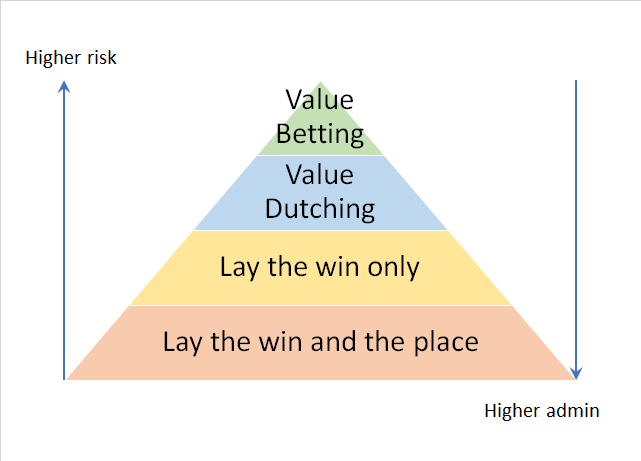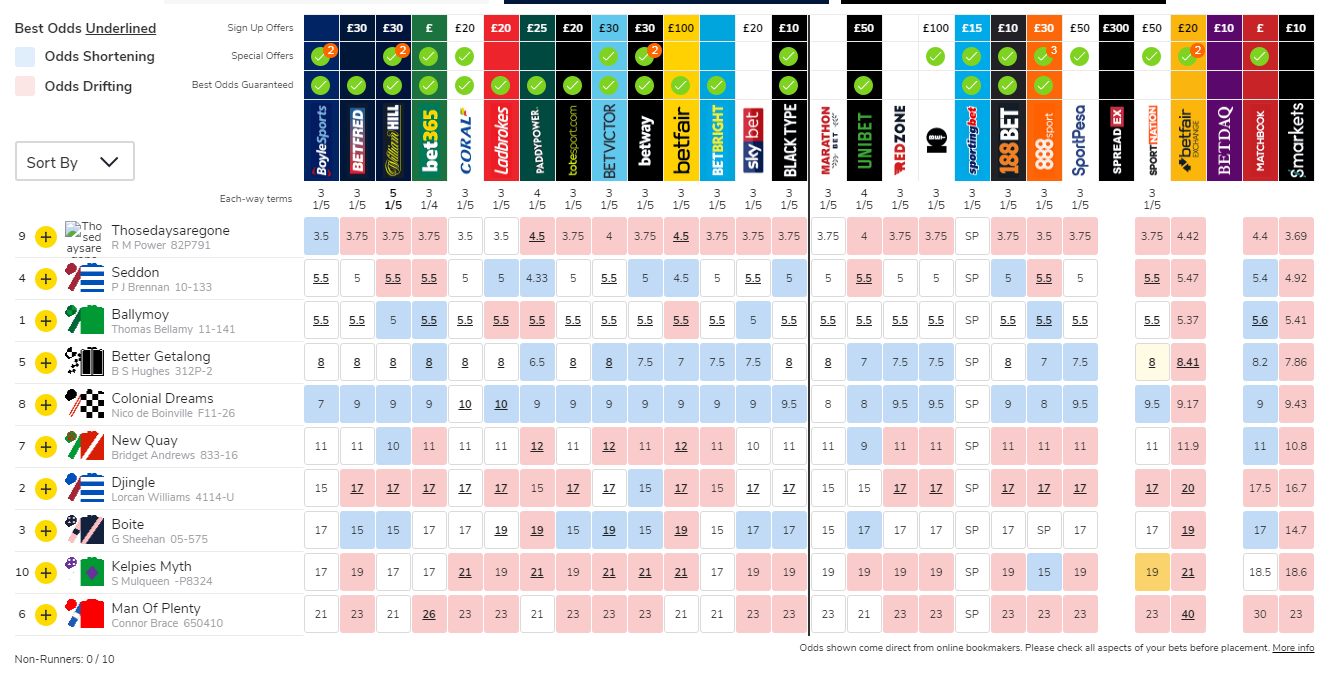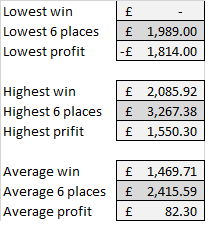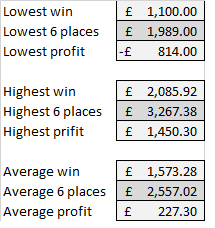- Value betting
- Dutching the race
- Laying the win only and targeting any place
- Laying the win and the place and targeting the EP
It is possible to make long term profit by betting on horse races where the terms are in our favour. The return can average 20% of overall stake placed on a race. By placing £1000 on various different horses in a race we can expect an average return of £1200.
Bookmakers often offer additional places in a horse race as a means for offering concessions. Unfortunately this is often at the expense of worse fractional terms.
In terms of value, it would be better to take ¼ standard places than 1/5 with a single extra place. If a bookmaker offers a single additional place at 1/5 odds then gloss over the offer; this is hardly a concession, it remains daylight robbery.
Not all Extra Places are worthwhile:
| Standard terms | Ignore | Worthwhile | |
| 2 to 4 runners | No place betting available | Any | |
| 5 to 7 runners | 2 places, ¼ | 3 places 1/5 | 3+ places ¼
4+ places 1/5 |
| 8 or more runners | 3 places, 1/5 | 3+ places ¼
4+ places 1/5 |
|
| Handicaps 12 to 15 runners | 3 places 1/4 | 4 places 1/5 | 4+ places ¼
5+ places 1/5 |
| Handicaps 16 or more runners | 4 places 1/4
|
5 places 1/5 | 5+ places ¼
6+ places 1/5 |
Identifying appropriate races to target.
The table above can be used to identify any races that may be worth targeting for place value. Its just as easy to scan oddschecker and look for any outliers, such as in the screenshot below where William Hill are a standout 5 places in a 10 horse field, 1/5 odds.
However just because they are standout in the number of places offered doesn’t automatically mean the race will be value. As can be seen from Oddschecker they are worst price on nearly every horse, so the question arises; how can we assess the value offered?
Assessing value in a race
Below is an assessment of a 14 runner handicap at Kempton on the 12th January 2018. William Hill were offering 6 places 1/5 on this race.
Win Value
The value of the win part of a race can be worked out by adding up all the probabilities of the win odds. When the sum of the probabilities are less that 100%, the bookmaker is taking a profit out of the race. The probability of each horse can be worked out by taking the reciprocal of the decimal odds. In the example above the win probability adds to 127%.
Place Value
To work out the value of the place part of the race we can sum up the probabilities, but this time we divide the sum by the number of places in the race to find the value.
| Win | Place | Win prob | Place prob |
| 8.5 | 2.5 | 11.76% | 40.00% |
| 6.5 | 2.1 | 15.38% | 47.62% |
| 29 | 6.6 | 3.45% | 15.15% |
| 11 | 3 | 9.09% | 33.33% |
| 21 | 5 | 4.76% | 20.00% |
| 67 | 14.2 | 1.49% | 7.04% |
| 10 | 2.8 | 10.00% | 35.71% |
| 15 | 3.8 | 6.67% | 26.32% |
| 15 | 3.8 | 6.67% | 26.32% |
| 6 | 2 | 16.67% | 50.00% |
| 3.75 | 1.55 | 26.67% | 64.52% |
| 15 | 3.8 | 6.67% | 26.32% |
| 19 | 4.6 | 5.26% | 21.74% |
| 29 | 6.6 | 3.45% | 15.15% |
| Total | 127.99% | 429.21% | |
| 3 places | 143.07% | ||
| 4 places | 107.30% | ||
| 5 places | 85.84% | ||
| 6 places | 71.54% |
The example above shows that whereas the standard 3 places is terrible value, once the paid places become 5+ the value switches to the side of the punter.
The balance to be made is to ensure that the loss of value in the win position of the race does not outweigh the gain of value from the place position.
Determining a value rating on each horse
There are two components to consider when determining the value on each horse.
- What is the value of the win component?
- What is the value of the place component?
There are various methodologies that could be used to determine the answer to these components. At bookiebashing, we choose to answer them through:
- The value of the win component = the bookie odds / exchange odds, where > 85% is worthwhile and
- The value of the place component = the implied odds obtained were the player to lay the place in search of an extra place, where > 100% is worthwhile
The screenshot above provides an EV rating for the race that allows us to work out whether the race is value or not.
4 strategies for extracting value from a race offering extra places are below. The decision to use a particular strategy is personal preference, but may be categorised depending on risk tolerance and the amount of expected volume:
- High risk tolerance = Value betting
- Medium risk tolerance and High volume = Dutching the race
- Low risk tolerance = Laying the win only and targeting any place
- Very low risk tolerance = Laying the win and the place and targeting the EP
- Value betting
Risk: High
A strategy that involves a high risk tolerance is value betting. This is useful where we don’t expect to get much volume on the race and has the benefit of being the least complicated and requires the least amount of administration.
Value betting requires an understanding of bankroll management and variance. Stake should always be adjusted to account for the magnitude of the odds. When calculating a stake size, it is necessary to only consider the worst case scenario of the Win Component. It is possible to use a fractional Kelly staking calculator to work out optimal betsize, however a more straightforward recommendation is to stake for a win liability equal to or less than 2% of a bankroll. By keeping bets stakes this low we can keep variance managed – a reasonably large downswing over 1000 bets would be approximately 10% of bankroll size.
The graph below will help visualise expected downswings. It shows a real life example of the variance and downswings during 2000 value bets with an average Expected Value of 108%. Each bet has a liability on the win of £200.
2. Dutching the race
Risk: High
Volume of bets: High
Backing every horse in the race is known as dutching the race. It is a strategy that involves a high risk tolerance (due to the uncertainty of the exposure, this is something that can be managed with experience). If we know that we can get significant amount of volume on the race (where the no. unrestricted bets > 1.5 x number of horses) then we can attempt to back every horse in the race, and balance the pay outs so that we are not overly exposed on any particular horse.
Start by backing the highest EV horses, and then over the day attempt to get on all other horses. Although it would be useful to get on the field first before topping up on horses for a second round of bets, it is common that a few of the horses are priced so badly that it is preferable to wait to see if the price gets improved.
It will be necessary to be able to assess the position of the race leading up to the off, and plug any gaps. This can be done by assessing the worst possible position and seeing if that can be improved. Whilst it is possible to dutch a race for no risk, it is common to have a downside. However as long as the majority of the bets in the race were positive expected value, then the average result will see a profit, and often a good result can see significant profit.
The example below shows the exposure in a race an hour before the off. The average profit expected on the race is positive, but the downside is relatively large. The outsider, Millrow, has not been backed due to the poor value on offer
Millrow is neither value to win nor to place, but by simply backing £50 EW at the 28/1 we can reduce our lowest profit from -£1.8k to -£814, which is a significant improvement to the risk in the race. The average profit in the race substantially improves aswell.
Further balancing in the race would be possible by using the graph to target the horses that return the lowest payout, such as And the New.
3. Laying the win only and targeting any place
Risk: Low
Min. volume of bets: Any
A good strategy for managing risk is to lay the win part only and leave the place unexposed. This has the dual function of managing the larger component of the each way bet (the win), whilst maximising the value component of the bet (the place). We can either fully lay or underlay the bet by e.g. 75%.
With this strategy it is important to focus on horses whose win price is close to the exchange price. It is rare to find arbs on the outright win when the bookmaker is also offering numerous additional places, however any back price that is over 85% of the lay win price will usually be good enough to back.
4. Laying the win and the place – Targetting the EP
Risk: Low
Min. volume of bets: Any
This strategy involves laying the win and the place components of the bet, in an attempt to hit a large payout if the horse finishes in the additional place – as both back and lay bets will win. Targeting the Extra Place was very popular in 2010-2015, but a lot of people became familiar with the technique which in turn made it much harder to do as it forced the bookmakers to alter the way they offered extra place concessions. The original page we wrote on this strategy in 2015 is here, however it focussed on bookmakers offering extra places at ¼ odds. As of 2019 this is no longer the available.
Whilst it is still possible use this strategy in races offering 1/5 odds, it is much more difficult. It is uncommon to find arbs, and therefore a consideration needs to be made as to the value of each horse. If we back a horse for 5 places, we can lay both the win and the place on the exchange at a number of places less than offered by the bookmaker (4 places would target 1 extra place, 3 places would target 2 etc.). By doing this, it is possible to win at both the exchange and the bookmaker if the horse finishes in the additional place:
As of 2019 we would rarely find a horse we can back and lay for net £0 overall loss, therefore a consideration has to be made of the value of each horse. This can be done by assessing the implied odds that are created by the qualifying loss. If we use the simplification that the odds of a horse finishing in any place at the top of the field is the same of the odds winning (an assumption that is fair in big handicaps, but less so in smaller fields) then value is assessed by:
Implied odds (IO) of extra place = Potential Payout (PP) / Qualifying Loss (QL)
PP = Potential Payout
QL = Qualifying loss
The Expected Value rating of the horse is then EV = Implied Odds / Win Odds.
IO = Implied Odds
WOe = Win odds (on exchange)
As long as EV is > 100% then we will expect to see a long term profit from the bet.










